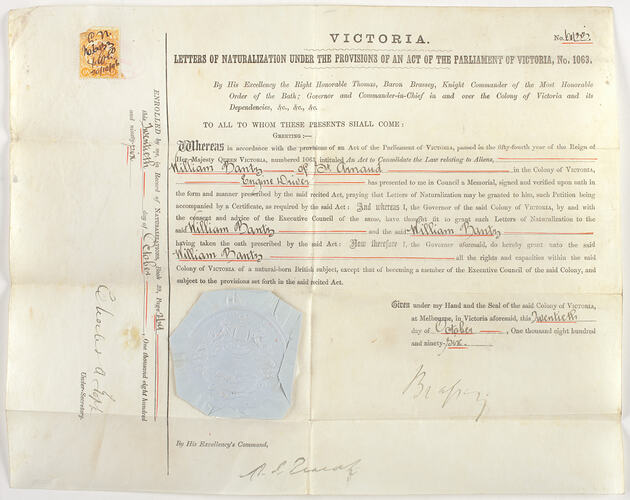Summary
Naturalisation certificate presented to William Bantry, probably originally from Ireland, an engine driver, by the Colony of Victoria, dated 20 October 1896. William was living in St Arnaud (near Avoca) when he was presented with this certificate.
Physical Description
Certificate on parchment, with a Victorian Governor's grey paper wax seal attached. Printed in black ink with handwritten personal details filled in, underscored in red ink. Also attached a one pound duty stamp.
Significance
This item is a valuable addition to the Museum's small collection of naturalisation certificates. Such certificates document the historical process of naturalisation and citizenship in Australia, from colony-specific legislation to naturalisation as a commonwealth responsibility post-Federation. They also trace local and empire definitions of nation and nationality, complex in the Australian context which was also wrapped up in notions of 'Britishness' and 'whiteness.' More research will be done when item goes on display regarding William Bantry to trace his migration story.
This particular certificate refers to an Act of the Parliament of Victoria (1890?) - 'An Act to Consolidate the Law Relating to Aliens' - as the legislation under which this naturalisation was approved. Naturalisation conferred on the recipient all rights 'of a natural-born British subject' in the colony of Victoria. In 1889, the Federal Council Referring Act (Victoria) included, amongst other things, the referral to the Federal Council of Australasia, the naturalisation of aliens of European descent. In 1904, the citizenship function was passed from the states to the Australian Government. Prior to 1949 (when the Nationality and Citizenship Act 1948 came into force), Australians were British subjects (it was not until 1984 that Australian citizens ceased to be British subjects). Colonial legislatures in Australia, as soon as they enacted naturalisation statutes enabling aliens to remain in their colonies, adopted British subjecthood as the way to describe the new status of those who had been naturalised. One Western Australian statute of 1841 declared a person so naturalised as "enabled to purchase and hold Lands, and to enjoy all the other Privileges of a natural born British Subject within the Limits of the Colony of Western Australia". With the establishment of the Commonwealth of Australia in 1901 British subjecthood immediately became enshrined in Commonwealth law. At Federation in 1901, 'British subject' was the sole civic status noted in the Australian Constitution. The Australasian Federal Convention of 1897-98 was unable to agree on a definition of the term 'citizen' and wanted to preserve British nationality in Australia. An administrative concept of citizenship arose from the need to distinguish between British subjects who were permanent residents and those who were merely visitors. This was necessary for the Commonwealth to exercise its powers over immigration and deportation.
The history of citizenship and nationality in Australia presents particular complications since Australia remained a component of the British Empire until quite recently, and as a result categories of civic belonging were primarily imperial rather than national ones. Until 1993 citizenship by birth was acquired in Australia under the regime of jus soli (law of the soil). Jus soli prevailed in Britain from 1608 when a test case (Calvin's case) established that anyone born on British soil held British nationality. Thereafter, all people born on British soil were attributed the status of British subjects irrespective of the nationality of their parents, and jus soli applied in New South Wales and later the other colonies from the time of their foundation. Various statutes dealing with naturalisation and nationality in Britain and the Australian colonies were passed from the 1840s but none disturbed this fundamental principle of British nationality. With the Nationality Act 1920 the Commonwealth instituted jus soli under its own statutes, and the Nationality and Citizenship Act 1948 also granted Australian citizenship to all people born in Australia (with a few minor exceptions). The great majority of people acquired their status as Australian citizens by birth. Additional provision existed for the formal status of British subject to be attributed to those people born of a British father outside British territory, and the same applied for the status of Australian citizen after 1948. Collectively, these people were 'natural-born' Australian citizens.
For those people not born as Australian citizens or British subjects, naturalisation was the only means by which they could acquire citizenship. The civic status of naturalised people was qualified in several important respects. First, during several periods, naturalisation was recognised only within the jurisdiction of the government that granted it: hence, a person naturalised in Britain was not a British subject in Australia and vice versa. This difference in civic status within the Empire was remedied by a scheme of reciprocal recognition set up between some British Empire countries in the 1920s. Until 1904 the same situation existed in Australia between the colonies, where there was no obligation for any colonial government to recognise people naturalised in any of the other colonies as being British subjects, although there were some provisions for reciprocal recognition. This situation was addressed by the Commonwealth's Naturalization Act 1903 which deemed all people who had been naturalised in any state to be British subjects throughout the Commonwealth. A second and more significant discrepancy that detracted from the civic status of naturalised people was the ability of Commonwealth and state governments to discriminate in legislation between natural-born and naturalised British subjects. And third, naturalisation - unlike birth - could be revoked, and the Commonwealth could strip a naturalised person of citizenship and then deport them.
Source: http://www.naa.gov.au/about-us/publications/fact-sheets/fs187.aspx; http://www.naa.gov.au/naaresources/Publications/research_guides/guides/ctznship/chapter1.htm; http://goliath.ecnext.com/coms2/gi_0199-4229431/Natural-born-subjects-Race-and.html
More Information
-
Collecting Areas
-
Acquisition Information
Purchase from L. Weir, 08 Nov 2007
-
Issued By
Colony of Victoria, Melbourne, Victoria, Australia, 20 Oct 1896
-
Issued To
-
Inscriptions
Text: VICTORIA/LETTERS OF NATURALIZATION UNDER THE PROVISIONS OF AN ACT OF THE PARLIAMENT OF VICTORIA, No. 1063.
-
Classification
-
Category
-
Discipline
-
Type of item
-
Overall Dimensions
372 mm (Width), 299 mm (Height)
-
Keywords

